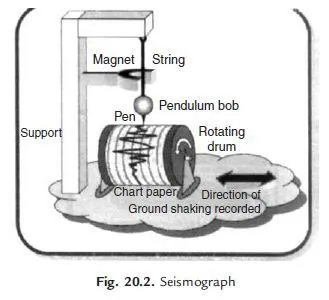Seismograph is an instrument for measuring oscillation of earth during earthquakes. It has three major components the sensor, the recorder and the timer. Figure 20.2 shows a typical seismograph. The pendulum mass, string, magnet and support together constitute the sensor. The drum, pen and chart paper constitute the recorder. The motor that rotates the drum at constant speed forms the timer. The pen attached to the tip of an oscillating simple pendulum marks on the chart paper. The magnet around the string provides the required damping to control the amplitude of the oscillation.

measuring vertical oscillations, the string pendulum is replaced with a spring pendulum, oscillating about a fulcrum. Thus three oscilloscopes are installed at each station to measure the oscillations in three mutually perpendicular directions.
Now a days analog instruments are giving way to digital instruments to record the ground motion and process it with microprocessors.